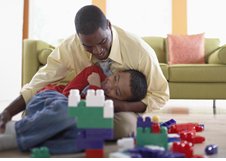DIR Floortime Model

This is a great video and informational guide to DIR Floortime, one of the only autism therapies focused on helping a child progress through the six basic developmental milestones. This treatment method may also include therapies such as speech therapy, occupational therapy and problem solving exercises. It is intended to focus more on social, emotional and intellectual capacities rather than a specific skill or behavior. Originally started by Dr Stanley Greenspan during the 1980’s, each part helps to build on existing strengths.
What does DIR Floortime mean?
DIR, which stands for Developmental, Individual difference, Relationship based Model, is a guide for parents and educators to create appropriate interventions for children on the spectrum centered on their current developmental level. Floortime therapy is a specific technique used involving activities based on this model.
Developmental: By understanding where they are developmentally, the clinician is able to better plan an appropriate treatment program. The six steps Greenspan describes include:
- Self regulation and interest in the world
- Intimacy or a special love for the world of human relations
- Two-way communication
- Complex Communication
- Emotional ideas
- Emotional thinking
Individual Differences
All children on the
spectrum tend to interpret and perceive sensory information in their own
unique way. Many children have difficulties with sensory processing
resulting in over-reactivity or under-reactivity to sensory stimuli, such
as sound and touch. They may have problems with motor planning and
sequencing. By learning what those individual differences are, a
therapist can better learn how to implement a treatment plan to be more
effective.
This refers to the relationships a child has within his/her environment
including parents, teachers, peers, and caregivers who modify their
interactions to be based on the child’s current developmental level and
individual differences.
The primary goal of DIR Floortime is to help the child achieve emotional
milestones that were previously not obtained during early development and that are
crucial to learning. As a treatment component of this model, individuals in the child's life work to help the child accomplish each milestone on the developmental ladder.
The following is a video illustrating this method of treatment:
Although the video is long, I found it to not only illustrate a DIR Floortime session, but it actually shows the relevant child at 7 months old, 18 months old, 2 years old, and 3 years old. During these scenes you can clearly see his signs of autism. Then the video shows him after six months of Floortime therapy. Honestly, the difference is very profound and inspiring. Despite this being an inspiring method of therapy, I would still recommend seeking out services for evidence based applied behavior analysis if you have a child diagnosed with autism. However, it's also recommended to always learn about a variety of therapies and their benefit, while incorporating the strengths of both interventions as a way to help them progress developmentally. This would involve doing activities based on the child’s social, emotional, and intellectual capacities as determined by the DIR Model, while still using the benefits of focusing on specific skills/behavior with the repetition and reinforcement that ABA provides.
For more information about Floortime go to www.icdl.com or checkout the following:
References
1. What’s DIR/Floortime?. The Interdisciplinary Counsel on
Developmental and Learning Disabilities.
http://www.icdl.com/dirFloortime/overview/index.shtml. 10-6-11.
2. History of Floortime http://www.icdl.com/dirFloortime/overview/index.shtml. 10-6-11.
3. Treatments for Autism. Autism Speaks. www.autismspeaks.org. 11-22-09.